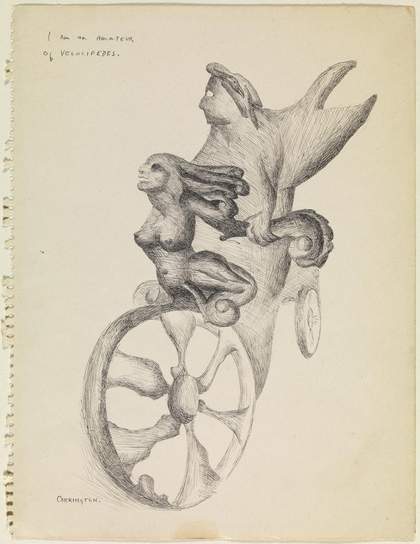Humour is one of the forms of melancholy.
Louis Scutenaire

Fig.1
Alfred Jarry
Veritable Portrait of M Ubu 1896
Woodcut
Frontispiece for Ubu Roi, Drame en cinq Actes en prose. Restitué en son intégrité tel qui’il a été representé par les marionettes du Théâtre des Phynances en 1888, Paris 1896
This paper explores the pataphysical dimension of Rodney Graham’s work, as a supplement to the existing critical literature on his art. The concepts used here come from two main sources: Jeff Wall’s early discussion of Graham’s work, ‘Into the Forest’, which was first published in 1988, and Dorothy Zwirner’s recent book on the work by Graham in the Flick Collection, published in 2004. These two essays frame the serious criticism of Graham’s work. Wall uses the Hegelian concept of ‘bad infinity’, or an infinite repetition of the same, to understand and situate Graham’s artistic production of the 1980s; Zwirner identifies the melancholy that she perceives in Graham’s work with the demise of the utopian thinking that motivated the artistic activities of the generation that preceded Graham. It is a question, as Serge Guilbaut put it so well in a 1997 essay on Graham’s work, of ‘how to live artistically after the end of utopias’.1 Both Wall and Zwirner situate Graham’s production within a modern and contemporary economic, social and cultural context, from which his gestures take their meaning. I accept this reading, to which I shall add a few supplementary observations of my own.
Wall’s essay introduces Hegel’s concept of ‘bad infinity’ to understand and interpret Graham’s work. According to Wall, Hegel distinguished between affirmative or transcendent infinity and negative or bad infinity in his Science of Logic (1812-16), to describe on the one hand a notion of freedom as continuous transformation and self-realisation, and on the other an abstract progress ‘which remains incomplete because there is no progress beyond this progress itself.’2 Both infinities are bound up with modernity, but by affirmative or transcendent infinity is understood ‘an unfinished state of liberation’ in which things change, while bad infinity is the eternal recurrence of the same even within contemporary culture. For Wall bad infinity ‘is also an image of mechanistic, routinised “progressive” modernity’.3 To the extent that Graham’s art refers to an earlier moment of modernity in its preoccupation with obsolete mechanical technologies, it can be said to take bad infinity as its subject, and even assume its logic; in this way, it is an image of unfreedom. Wall certainly thinks of it this way when he discusses Graham’s 1983 work Lenz as an example of bad infinity that is both symptomatic and diagnostic of ‘this modernity, which is ours’.4
While Matthew Teitelbaum may be the first writer to describe Graham’s art as melancholic, in 1994, this description is the subject of Dorothy Zwirner’s book-length essay ‘Melancholic Masterpieces’, which is at the date of this writing the most recent criticism of Graham’s work, as well as one of the most substantial.5 Zwirner situates Graham’s particular melancholy in relation to the end of utopian thinking in her discussion of his 1997 film Vexation Island:
In this cycle, we can recognize the peculiar interplay between melancholy and Utopia characteristic [of] this type of the intellectual. The intellectual laments the condition of the world, and from this lament emerges utopian thought, which sketches out a better world and thereby dispels melancholy. Yet the end of Utopia leads to a return of melancholia.6
In his ‘Mourning and Melancholia’ (1917), Sigmund Freud suggests that these two forms of grieving are either responses to the loss of a loved person, or to the loss of some abstraction such as one’s country, an ideal, etc., with the difference that mourning is something that one gets over, while melancholy can become a permanent pathological condition if not worked through.7 In the interpretation Zwirner gives to Graham’s work, melancholy is a response to the loss of an ideal, and the return to an earlier mechanistic moment of modernity, referred to in so many references to or uses of obsolete technology, is a return to the revolutionary promise of human betterment embodied in these outmoded technologies, and at the same time to the endless repetition of the industrial era, which failed to deliver on that promise.
I, too, wish to approach Graham’s practice with these issues and this perspective in mind, and to supplement them with a discussion of the pataphysical dimension of Graham’s work, in keeping with my understanding of the role and situation of ‘pataphysics in twentieth-century art and thought. It is quite possible that I am imagining this pataphysical dimension, since Graham himself never mentions Alfred Jarry or ‘pataphysics in his descriptions of his works, but I do not believe it is just my delirium of interpretation that finds it there.
In a recent review of my book on surrealism, Charlie Miller described it as a melancholy one, in its conclusion that surrealism failed to realise its aim of founding another culture.8 If the colour of my book is in fact a little blue, in my view the failure of surrealism was due not so much to its internal contradictions – though these existed, of course – as to the splintering of its revolutionary aspirations against the revolutionary nightmare of the Soviet Union under the rule of Stalin, and against the ‘bad infinity’ of unchanging social relations in market regimes, where commercial considerations (and not just economic ones) dictate social policy.
My current research is focused on that splintering, and thus might be construed as melancholy. I am interested in what I would call the ‘afterlife’ of surrealism, even where the continued existence of surrealist groups in postwar France and elsewhere is concerned. For although the end of utopian thinking is commonly identified with the 1970s and postmodernism, and is the immediate context for Graham’s melancholy (though we have yet to establish this), my research has made me aware that this perspective was already quite widespread in the 1950s among those who had in some way been involved in the surrealist enterprise. The surrealist group itself remained invested in utopian thinking in the 1950s, but many of those who left it also abandoned utopia. One of the formations I have been investigating is the College of ‘Pataphysics, which was populated by former surrealists like Raymond Queneau, Jean Ferry, Jacques Prévert, Michel Leiris, Max Ernst, Joan Miró, Man Ray, Simon Watson Taylor, Pol Bury and Noël Arnaud – aside from many others who had nothing whatsoever to do with surrealism. My research into the College, though by no means complete, has enabled me to imagine or discern certain pataphysical features of Graham’s work that have been overlooked by others – though I should acknowledge that Anthony Spira has preceded me here by noting some of these in his catalogue essay for the Whitechapel exhibition of Graham’s work in 2002.9
Now, what is ‘pataphysics exactly, and how is it related to the College that takes its name? ‘Pataphysics was the brainchild of the symbolist writer Alfred Jarry, best known for his character and his play Ubu Roi, who laid the foundations for pataphysical thinking in his novel Exploits and Opinions of Doctor Faustroll, Pataphysician, completed in 1898 but not published until 1911, four years after the author’s early death at the age of thirty-four. The exegetes of the College claim that everything one needs to know about ‘pataphysics is in Faustroll, and it is true that the major pronouncements of the College’s doctrine hold quite tightly to the ideas suggested there. There are two related definitions of ‘pataphysics that I wish to point out here:
- ”Pataphysics is the science of imaginary solutions’, which implies that all solutions to any problem whatsoever, scientific or otherwise, are imaginary in nature; and
- ‘Pataphysics is the science of exceptions – in other words, there are no universally valid laws such as science seeks to discover; laws or principles can only be legitimately applied to particular cases, and are in any case imaginary in nature.10
The one principle that holds water in this exceptional universe is the principle of equivalence: that any solution is as good as any other, all things being equal. In this way, Jarry counters the scientism of his era, with its complementary faith in progress, and his novel can be viewed as an imaginary triumph over the law, and over laws in general. It is narrated by the bailiff Panmuphle, who comes to Faustroll’s apartment to serve him eviction papers for his failure to pay the rent, but who is overpowered by Faustroll and made to row his paraffined sieve for the duration of their fantastic voyage through contemporary art, literature and science. Significantly, Panmuphle has his back to the future, and has no idea where he is headed.
There several pataphysical motifs in Graham’s work – or at least I think I see them there – but I want to focus on two: the clinamen and the spiral. Graham has written about the clinamen on two occasions, and it informs his work in general. This concept, which is featured in Faustroll and which is foundational to ‘pataphysics, was the Roman author Lucretius’ term for what the Greek philosopher Epicurus understood to be an indeterminate swerve in the downward motion of atoms. The concept of the clinamen was used to refute the idea of a uniform, fatalistic flow of atoms, which had previously been suggested by Democritus. Here is Graham’s own definition of the clinamen:
The word is from Lucretius, for whom it signifies the sudden and unpredictable swerve of a single atom from its otherwise pre-ordained trajectory … It is the clinamen, according to the physicist, that breaks the endless chain of fate and yields the law of nature.11
Lucretius, following Epicurus, described an exception to the fatalistic understanding of matter by Democritus, as a kind of free will that was a property of atoms themselves. To this extent, the unmotivated swerve or clinamen becomes the locus and the guarantor of free will in general, against fatalistic thinking.12 The concept of the clinamen underpins Jarry’s understanding of ‘pataphysics as the science of exceptions, which attempts to undermine all claims to universal validity. Graham makes a particular application of this concept, which we will come to later.
The second motif that Graham takes over from ‘pataphysics is the spiral (fig.1), which is inscribed on Père Ubu’s belly and which became the symbol of the College of ‘Pataphysics from its inception in 1948. The spiral is brought up twice in Faustroll, each time in relation to progress; in other words, the motif of the spiral is understood as a movement outwards, which is potentially infinite in its expansion.13 While neither Jarry nor the College of ‘Pataphysics accept the commonplace understanding of progress as human betterment, and while progress here is imagined as a spiral rather than a straight line, it does figure the eventual extension of a pataphysical understanding in which everything, every value, has become equivalent, in which every phenomenon is viewed with equal interest and where nothing is true. Founded by a small group of men, women and reptiles in 1948 (forty-one years after Jarry’s death), the College of ‘Pataphysics understood itself to be an institution for purposeless research, which was anti-foundational in nature albeit hierarchical in organisation and bureaucratic in its functioning. Founded as it was in 1948, it was rather sharply oriented against two contemporary tendencies that were themselves deeply antagonistic to one another: existentialist commitment, and surrealism. These were its two most frequent targets, in part because of the revolutionary or utopian political values represented by these tendencies, but also, in regards to the second of these targets, due to the personal experience of many of its members in the surrealist group. André Breton could still say in 1951 that ‘poetry must lead somewhere’, a notion that is rejected in principle by the College, which upholds the view that no idea is worth more or less than any other: as one of its early members, J.J. Mauvoisin, wrote in 1956: ‘our College . neither seeks effects, nor seeks to have any effect. It is an end in itself.’14
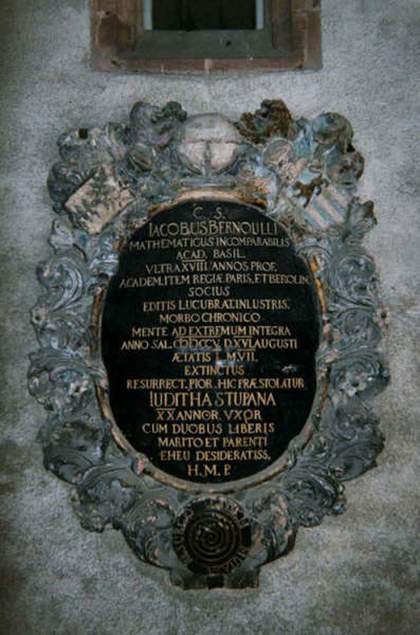
Fig.2
Jakob Bernoulli
Funerary Inscription, Münster, Basel 1705
The College, which is founded on a fiction, has as its director or curator Faustroll, who is fictional; the phenomenal director or vice-curator of the College may or may not be human or fictional; currently, the vice-curator is one of the reptilian founders of the College, Lutembi, a crocodile who lives on the shores of Lake Victoria in East Africa, and who has contributed several important essays over the years to the College’s periodicals. Lutembi is the fourth vice-curator in the College’s history. At the beginning of the magistrature of the third vice-curator, Opach, in 1965, Raymond Queneau introduced the device and motto of the Swiss mathematician Jakob Bernoulli to the College as a sign of renewal, and they have since been incorporated into its insignia (fig.2). In the late seventeenth century, Bernoulli developed the mathematical formula for what has been called the logarithmic, equiangular or sesquialteral spiral, whose proportions remain the same even as it expands in size. Bernoulli was referring to his spira mirabilis, as he called it, when he had a spiral and the Latin motto EADEM MUTATA RESURGO inscribed on his funerary plaque. It was this device and this motto – which can be translated as ‘I arise again the same though changed’ – that Queneau introduced to the College in 1965, and which it adopted: for instance, in Stanley Chapman’s design for the Subsidia Pataphysica series of College periodicals (fig.3). The design of Bernoulli’s funerary plaque was later used for the Organographes series of College periodicals in the 1970s and ’80s and for some of its publications (fig.4).15 As a self-similar spiral whose proportions do not change even as it grows in size, the logarithmic spiral becomes the emblem of an institution that does not believe in qualitative change of the kind sought by communists or surrealists, and which sees itself as persisting unchanged in its essence throughout what Jarry called ‘ethernity’. In other words, while the self-similar spiral figures both identity and difference (‘I arise again the same though changed’), it does not automatically figure progress, despite Jarry’s own identification of the spiral with progress in Faustroll.
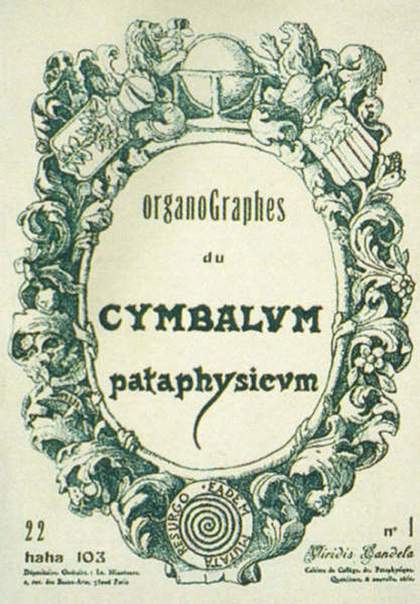
Fig.4
Thieri Foulc
Cover illustration for Organographes, no.1, 1975
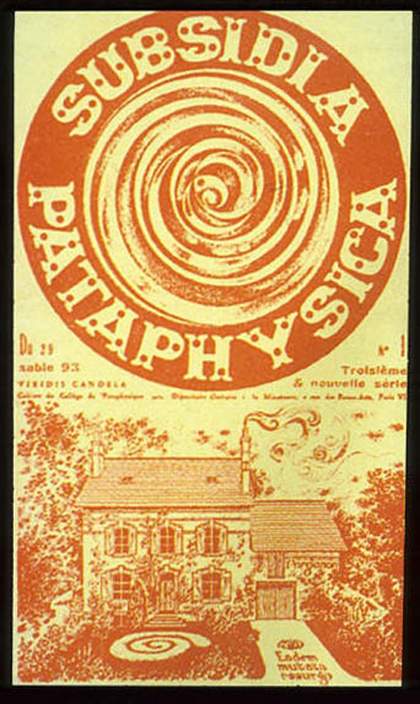
Fig.3
Stanley Chapman
Cover illustration for Subsidia Pataphysica, no.1, 19 December 1965
Graham has written of the clinamen on two occasions: his essay ‘Freud’s Clinamen’ was included in the catalogue for the 1987 Münster Sculpture Projects, to accompany his contribution to that exhibition which first brought him to international attention; and in 1997, his essay ‘Siting Vexation Island’ was published in the periodical-cum-catalogue that accompanied his short film Vexation Island for the Venice Biennale of that year, which raised his reputation to a new level.16
Graham’s Münster installation, and the essay that went with it, are concerned with one of Freud’s own dream accounts in The Interpretation of Dreams, the ‘dream of the botanical monograph’. While we do not need to go into the details of this dream, I want to touch briefly on their significance for Graham’s understanding of the clinamen. While out and about, Freud happened to see in a bookshop window a monograph on the cyclamen plant, which made its way into a subsequent dream. For Freud, this was a dream of ambition (of seeing his own book finished) which depended on the residues of the previous day for its manifest content; but for Graham it is an instance of the clinamen, or swerve, as Freud’s attention was drawn by the chance sighting of a book cover to which he attached no importance at the time. If Freud hadn’t gone that way, or if his attention had been drawn elsewhere, the botanical monograph would not have entered his dream, would not have been analysed in his famous book, and would not have been the occasion for a Rodney Graham work. What is decisive here, I think, is that Graham identifies the clinamen with the glance at the shop window, with consumer society, and thus with the experience of modernity.17 His installation consisted of dummy copies of the same botanical monograph Freud spied in 1898 placed in amongst other books in the window displays of bookshops around Münster; in this way, Graham stages the same sort of chance encounter in 1987 that Freud had experienced in Vienna nearly ninety years before, which is similar to the involuntary swerve or attraction experienced by hundreds of millions of people on a daily basis.
In his 1997 essay about Vexation Island, Graham writes of what he calls the ‘clinomatic instant’, and identifies this with the cyclamen, with the clinamen, and of course with the cinema, as Vexation Island is a nine-minute film loop shot in cinemascope.18 This film is a repeating loop of the kind that has been such a prominent feature of Graham’s work since the early 1980s. In ‘Siting Vexation Island’, Graham writes about the ‘clinomatic or catastrophic instant’ (fig.5) that draws the shipwrecked sailor back to the tree he shakes, which causes the coconut to fall, which knocks the sailor out, who wakes again and repeats the vicious circle that is formally embodied in the film loop itself, as an endless repetition of the same or a ‘bad infinity’.19 Tellingly, the ‘catastrophic instant’ is the clinamen which draws the sailor back to the tree, as Freud was drawn to the display of the monograph in the bookshop window, and Graham makes this identification explicit in his essay:
As I have made clear elsewhere, it was a monograph on the common house plant cyclamen that set in motion Freud’s Dream of the Botanical Monograph. Freud’s glimpse of the recent publication in a Vienna bookstore defined the clinamen – the unpredictable veering away of attention – that interposed itself into Freud’s daily routine. It is the clinomatic or catastrophic instant that I desire to place at the exact centre of Vexation Island.20

Fig.5
Rodney Graham
Vexation Island 1997
(still) Video/sound installation, 35 mm film transferred to laserdisc, 9 min continuous loop
Courtesy Donald Young Gallery, Chicago © Rodney Graham
The swerve that is described in each instance is more unfreedom than free will, more overdetermination than indetermination, which Graham figures in comic fashion. In identifying the clinamen with the seductions of the shop window, Graham describes both the aleatoric lure of the individual object, which has to be seen to be desired, and the unending sameness of this relation, which is catastrophic. This, I believe, is the point of Graham’s conjugation of clinamen and consumption.
In this sense, Vexation Island and some of Graham’s other loop works are parables of the ‘bad infinity’ of contemporary market society, whose logic Jeff Wall discerned through the analysis of works made before the films were even imagined. In Lenz of 1983, for instance, Graham appropriated an unfinished novella by Georg Büchner in which the mentally unstable protagonist, Lenz, wanders through a forest. The artist reset the type on pages one to two and on pages five to six of an English translation of the story, to set up a situation in which the page breaks at the same phrase ‘through/the forest’, which establishes a loop whose effect is to cause Lenz to endlessly repeat his journey by returning from page five to page two; in 1993 (fig.6), Graham had a reading machine constructed for this version of the text to facilitate the repetition, and the hardcover version of the 1983 work was a book bound with eighty-three repetitions of these pages, which in principle can be continued forever.

Fig.6
Rodney Graham
Machine for Reading Lenz 1983–93
Printed paper, glass, perspex, stainless steel and wood
Courtesy the artist and Lisson Gallery, London © Rodney Graham
The loop is not of course identical to the spiral in its form, and Graham in fact carefully distinguishes between the spiral that film is, and his own film loops, which are made visible for instance (fig.7) in the looping mechanism outside the little theatre built to show his 1996 film loop Coruscating Cinnamon Granules (whose central image is a spiral).21 There are three works by Graham that feature the spiral, among the many that privilege the loop: his 1987 novel The System of Landor’s Cottage; Coruscating Cinnamon Granules, just mentioned; and The Phonokinetoscope of 2001.

Fig.7
Rodney Graham
Coruscating Cinnamon Granules 1996
16 mm film loop in black and white, 4 min, purpose-built kitchen-sized cinema with eight cinema seats
Courtesy the artist and Lisson Gallery, London © Rodney Graham
The System of Landor’s Cottage is an appropriation and extension of Edgar Allan Poe’s last published story ‘Landor’s Cottage’ (1849), from its original ten or so pages to more than three hundred. It consists of a series of narratives nested inside one another, in imitation of Raymond Roussel’s series of bracketed observations in his New Impressions of Africa (1932).22 Graham’s novel opens out from Poe’s description of a landscape and a country cottage to describe an annex to the cottage, which he interpolates into Poe’s largely descriptive tale. The annex occasions the series of narratives that explain the reasons for the presence of its fantastic contents. One of the narratives concerns the writing of an eleven-volume set of memoirs by a composer named Sligo, who has plotted a code in his memoirs in the shape of a spiral. Once deciphered, the letters of the code spell the word ‘EUTERE’, which though missing a letter is still recognisable as the name of Euterpe, the muse of lyric poetry.23 The names of the other classical muses also appear in Sligo’s memoirs – with the exception of Clio, the muse of history. When fully deciphered, the code at the heart of Sligo’s memoirs and of Graham’s own novel reveals the phrase ‘EADEM MUTATA RESURGO’, ‘I arise again the same though changed’, which was Bernoulli’s description of the self-similar spiral.24 There is an obsidian tabletop in the annex with the same motto in spiral formation. While Clio, or history, is literally absent from Sligo’s text, she is anagrammatically figured as the coil or spiral in which the motto is inscribed. That is, history, which Hegel identifies with freedom, is replaced by a figure which, in being self-similar, is identified with repetition rather than change. This same tabletop is also identified by Graham with the spiral form of a record, since a copper stylus repeatedly traces its grooves in the annex to Landor’s cottage. In the final pages of the novel, Graham reveals that this cottage, while rectilinear in design, is conceived according to the proportions of a sesquialteral (or self-similar) spiral, with each wing half again as large as the preceding wing, in a proportion of three to two. Allan Landor has a notebook entitled ‘The System of My Cottage’, which envisages a total of fourteen additions to the original cottage, which will arc out into the valley in an architecture of increasingly fantastic scale, while maintaining the same proportions of three to two as the cottage itself: ‘I arise again the same though changed.’25
Graham returns to the spiral form in his 1996 film Coruscating Cinnamon Granules (fig.8), which is both cosmic and banal in its depiction of cinnamon burning and ‘coruscating’ on a stove element. The correlation between the words ‘cinnamon’ and ‘cinema’ has been noted before by Alex Alberro, which is one part of a declension from cyclamen to clinamen to cinnamon to cinema, which brings together the clinamen and the spiral in Graham’s thinking.26
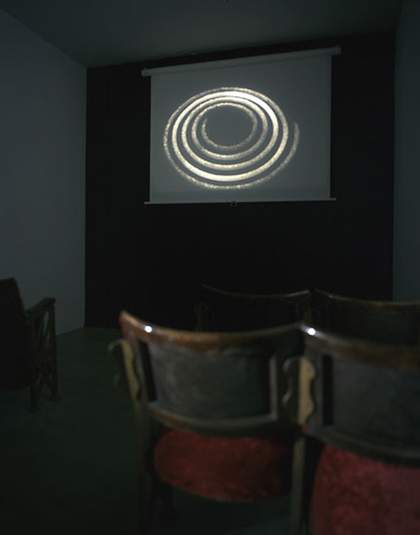
Fig.8
Rodney Graham
Coruscating Cinnamon Granules 1996
16 mm film loop in black and white, 4 min, purpose-built kitchen-sized cinema with eight cinema seats
Courtesy the artist and Lisson Gallery, London © Rodney Graham

Fig.9
Rodney Graham
Camera Obscura Mobile 1996
Mixed media
Courtesy the artist and Lisson Gallery, London © Rodney Graham
I have identified a link between the absence of Clio, or history (which is the inability to realise freedom) and ‘bad infinity’, and at this juncture I would say that ‘pataphysics is a way of learning to live within constraints, as utopian solutions, if not refused outright, are made equivalent to everything else.27 Graham is very fond of obsolete technology, which is identified with an earlier moment of modernity, including its promise of change. His fascination with the camera obscura is part of this, and he comically re-invents its development into a portable camera as the Camera Obscura Mobile (1996) (fig.9), in which the passengers seated inside are not looking out at the view rolling by beside them, but instead at the screen in front of them, by means of which they see an inverted image of the disappearing scene behind them. In The Phonokinetoscope (fig.10), and in the weathervane whose figure is taken from this film loop, Graham performs the childhood trick of riding his bicycle backwards.28 This is very much the vantage point of Panmuphle, and as writers like Robert Linsley and Shep Steiner have observed, this is also the vantage point of Walter Benjamin’s angel of history driven into the future by the storm of progress, a tragic theme that is given here comically and banally.29 In a passage from The Arcades Project that is linked to his image of the helpless angel, Benjamin writes: ‘The concept of progress must be grounded in the idea of catastrophe. That things are the ‘status quo’ is the catastrophe . hell is not something that awaits us, but this life here and now.’30 I think the weather vane makes this association with the angel of history explicit, though deliberately without the pathos of Benjamin’s image. Progress drives the angel forward, but the catastrophe is not some exceptional disaster in store for humanity; rather, it is Hegel’s concept of progress in which ‘there is no progress beyond this progress itself’, which we experience today and which is the cause of Graham’s melancholy. The very ordinariness of the weathervane’s figure is in keeping with this interpretation of Benjamin’s angel.

Fig.10
Rodney Graham
The Phonokinetoscope 2001
(still) 16 mm film installation with modified turntable, 33⅓ rpm vinyl LP
Courtesy 303 Gallery, New York © Rodney Graham
In The Phonokinetoscope, Graham pays homage to three figures: Thomas Alva Edison, who invented the phonokinetoscope of the title, which was an early attempt to link sound and image; Albert Hofmann, the inventor of LSD; and Syd Barrett, early leader of Pink Floyd and famous acid casualty. Image and sound are joined in a non-synchronous way, so that the film loop and the soundtrack, written by Graham in emulation of acid rock, repeat at different intervals, and the whole apparatus is triggered by lifting the arm of a record player and placing its needle on a vinyl record. Graham sings and plays the music, and appropriates the refrain from Barrett’s song Bike (from Pink Floyd’s first album Piper at the Gates of Dawn, 1967). He rides a bike in the film and takes a tab of LSD, in emulation of Hofmann, who rode his bike home during his own first trip. The bicycle is also associated with Alfred Jarry, who used it as his way of getting around at a time when it was a modern invention.
While other works by Graham display a nostalgic relation to obsolete technology, this film in particular seems filled with yearning for the artificial paradises and the utopian politics promised by the counter-culture, which Graham experienced as a young man. Three different moments of invention – the 1880s, the 1940s, and the 1960s – are associated with the promise of freedom and self-realisation, though all of them are located in the past, and we see Graham regressing to his own past here with his bicycle trick.
I would like to conclude these reflections by thinking about two recent works: A Reverie Interrupted by the Police, 2003, and Fantasia for Four Hands, 2002. The idea for the former (fig.11) was prompted by a remark made by André Breton in his 1951 essay on film, ‘As in a Wood’. In it, Breton mentioned a radio broadcast that featured ‘a bit of piano playing by a handcuffed man’, which Graham has transposed into a vaudeville scene with a prisoner and his guard – not presented aurally as Breton heard it, but visually in the form of an early spectacle.31 In this loop, the prisoner, whose uniform resembles the keys of his instrument, is playing a piano prepared in the manner of John Cage, though his playing is of course hobbled by the handcuffs. The film suggests not just the artist as criminal, which is a longstanding modern trope of the artist, but abjection, as the artist-performer is controlled by authority – and authority here not only interrupts the performance/reverie, but returns the artist to it repeatedly. In this case, it is not so much the melancholy performance on screen that is important, as the logic of the loop, and the artist’s role in this eternal recurrence. ‘Poetry must lead somewhere’, Breton claims elsewhere in his essay ‘As in a Wood’, but this imperative is overlooked in Graham’s film in favour of an aural image that denies it, and to which Breton has called attention for this very reason. Even experimental art, Graham seems to suggest in preparing the piano, is subject to bad infinity, leads nowhere else.
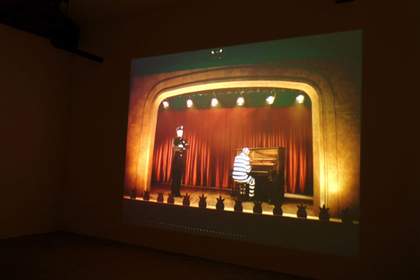
Fig.11
Rodney Graham
A Reverie Interrupted by the Police 2003
(still) DVD, video projector, four speakers, subwoofer and amplifier, 35mm film transferred to DVD, 7 min 59 sec, continuous loop Courtesy Donald Young Gallery, Chicago
© Rodney Graham
Fantasia for Four Hands (fig.12) is likewise focused on the role of the artist (again as piano player), quadrupling the artist’s presence in the manner of Jeff Wall’s Double Self-Portrait of 1979. Graham has based his self-portrait on the cover of a Dutch LP featuring a piano-playing duo similar to Ferrante and Teicher, whose routine was partly comic. That is, the reference to the commercial role of music as entertainment is as clear here as it is in A Reverie, and reinforced by the baffle panels in International Klein Blue, which refer to the paradigm of the artist as showman.
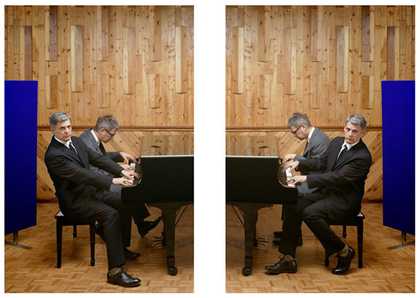
Fig.12
Rodney Graham
Fantasia for Four Hands 2002
Two colour photographs
Courtesy Donald Young Gallery, Chicago © Rodney Graham
Graham has referred to Freud’s use of the Greek word ‘allotrion’, or ‘other path’, twice: in ‘Freud’s Clinamen’ in 1987, and again in 1999, in the endpapers for his Vienna Kunsthalle catalogue.32 This allotrion is synonymous with the clinamen, in that it signifies a swerve or deviation from one’s path: not just the swerve of attention to the shop window, but in Freud’s case, his swerve from neurology to psychoanalysis, or Graham’s own swerve in the 1980s to his research on Freud, to his further research for The System of Landor’s Cottage, or his more recent return to pop music, which is just as pronounced a clinamen as any other, and which conditions his self-presentation as musical performer in A Reverie and Fantasia. Graham writes, in ‘Freud’s Clinamen’: ‘It is the ‘allotrion’, the too-absorbing hobby, the other path that holds the promise of another vista, and that, in the course of more serious endeavors, carries one’s thoughts elsewhere.’33
At the same time, this deviation is presented as being no different from the straight path of the falling atom (or for that matter, the coconut), in the same way that the spiral is no different from the loop or the circle. There is an effort to escape, but the only true escape is through laughter. Moreover, I think it can safely be said that Graham represents a certain truth about the contemporary institutionalised situation of the artist, as opposed to the utopian views of the past in which it was felt that art really could be a means of liberation; this is the sense of Breton’s claim that ‘poetry must lead somewhere’, which Graham swerves from in favour of the image of a shackled art. Breton would have us enact that liberation in the making of the work, whereas Graham mourns its loss. In other words, Graham is showing us ‘how to live artistically after the end of utopias’. In this way, his work is both symptomatic and diagnostic of ‘this modernity, which is ours’, much as it was in 1988. While Graham might not have taken the motifs of the clinamen and the spiral directly from ‘pataphysics, both the relinquishment of utopia and the little escape figured by the clinamen are at play in his works, as they are in the exploits and opinions of the College. The self-similar spiral and its motto figure identity and difference simultaneously, as does the clinamen in the interpretation Graham gives to it: the lure of the commodity that traps us in the vicious circle of a history not of our own making, which we repeat because we do not remember, all things being equal.

